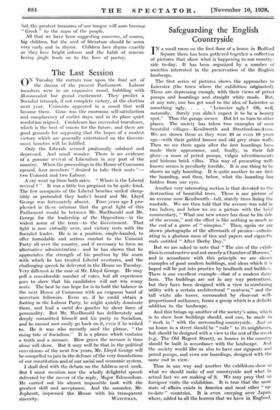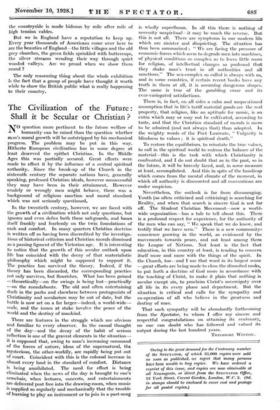Safeguarding the English Countryside
IN a small room on the first floor of a house in Bedford Square there has been gatImed together a collection of pictures that show what is happening to our country- side to-day. It has been organized by a number of societies interested in the preservation of the English landscape.
The first series of pictures shows the approaches to Leicester (the town where the _exhibition originated).
These are depressing enough, with their views of petrol pumps and hoardings and straight white roads. But, at any rate, one has got used to the idea of Leicester as something ugly. . . . "Leicester ugly ? Oh, well, naturally. Surely you didn't expect it to be a beauty spot." Thus the garage owner. But let us turn to other places. The society has taken two examples of once beautiful villages—Kenilworth and Stratford-on-Avon.
We are shown them as they were 20 or even 10 years ago—with their gabled houses and old grey stone walls.
Then we see them again after the first hoardings have made their appearance, and, finally, in their full glory—a mass of petrol pumps, vulgar advertisements and hideous brick villas. This way of presenting well- known scenes is peculiarly forcible. It is one thing to be shown an ugly hoarding. It is quite another to see first the hoarding, and then, below, what the hoarding has hidden from our eyes.
Another very interesting section is that devoted to the destruction of beautiful trees. There is one picture of an avenue near Kenilworth—tall, stately trees lining the roadside. We are then told that the avenue was sold in two halves, and below we see a picture with the brief commentary, "What one new owner has done to his side of the avenue," and the effect is like nothing so much as the end of a game of "ninepins." Then, again we are shown photographs of the aftermath of picnics—culmin- ating in a glorious mess of tins and papers and cigarette ends entitled "After Derby Day."
But we are asked to note that "The aim of the exhib- ition is constructive and not merely a Chamber of Horrors," and in accordance with this principle we are shown examples of good modern buildings, and ideas which it is hoped will be put into practice by landlords and builders. There is one excellent example—that of a modern dairy farm. The buildings are not in any way pretentious, but they have been designed with a view to combining utility with a certain architectural "neatness," and the tall white silo tower, surrounded by clear-cut well- proportioned outhouses, forms a group which is a definite addition to the landscape.
And this brings up another of the society's aims, which is to show how buildings should, and • can, be made to "work in" with the surrounding countryside. Just_ as no house in a street should be " rude " to its neighbours, but should be designed with a view to the rest of the street (e.g., The Old Regent Street), so houses in the country should be built in accordance with the landscape. And the society would like us also to have our signposts and petrol pumps, and even our hoardings, designed with the same end in view.
Thus in one .way and another the exhibitors.show us what we should make of our countryside and what in actual fact we are making of it. We may pray that no foreigner visits the exhibition. It is true that the same state of affairs exists in America and most other " up- to-date " countries. It is -even creeping over Japan, where, added to all the horrors that we have in England, the countryside is made- hideous by mile after mile of high tension cables. But we in England have a reputation to keep up. Every year thousands of Americans come over here to see the beauties of England—the little villages and the old grey churches, the green fields sprinkled with buttercups, the silver streams wending their way through quiet wooded valleys. Are we proud when we show them round?
The only reassuring thing about the whole exhibition is the fact that a group of people have thought it worth while to show the British public what is really happening to their country.













































 Previous page
Previous page